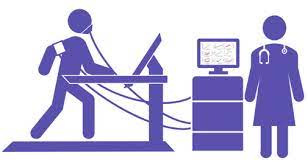Exercise Induced Bronchospasm Tests
Description[edit | edit source]
Exercise-induced bronchoconstriction (EIB) is the phenomenon of narrowing of the airways (transient and reversible) during and after exercise that occurs in response to increased ventilation in susceptible individuals. Exercise is the most common trigger factor in individuals with EIB. Clinical presentation may include dyspnoea, wheezing, cough, chest tightness, excessive mucus production or the feeling of a lack of fitness. EIB can occurs in patients with or without asthma. EIB can be confirmed based on the variations in lung function triggered by exercise, rather than on the basis of symptoms. The two diagnostic methods include spirometric and bronchoprovocation techniques.
Methods To Quantify EIB[edit | edit source]
Spirometry[edit | edit source]
According to American Thoracic Society /European Respiratory Society guidelines, FEV1 maneuvers are recorded after exercise with the highest acceptable value recorded at each interval ( 5, 10, 15, and 30 minutes). A decline in FEV1 ≥10% from baseline after exercise or hyperpnoea is used a confirmation for positive EIB. The difference between the pre-exercise FEV1 value and the lowest FEV1 value recorded within 30 minutes post exercise is used to determine the severity of EIB:
- mild, 10– < 25%;
- moderate, 25– < 50%
- severe ≥50%
Bronchoprovocation Test[edit | edit source]
- This test is performed by breathing dry air at 10 mg H2O/L with a nose clip in place while completing an exercise challenge. Methacholine challenge is widely used method in bronchoprovocation test. It consists of two versions a standard protocol and a rapid protocol. The ideal protocol involves a rapid increase in exercise intensity over approximately 2–4 minutes sufficient to raise the heart rate to 80–90% or ventilation to reach 17.5–21 times FEV1. Once this level is reached the subject should continue exercise for an additional 4-6 minutes. The use of asthma medications, warm-up exercise, the use of nonsteroidal anti-inflammatory medication, and recent exposure to inhaled allergens may alter the severity of the response to exercise testing.
- Eucapnic Voluntary Hyperventilation (EVH) is a laboratory test, well-standardized that is both quick and easy to administer. Dry air (containing 5% carbon dioxide) is hyperventilated at room temperature for 6 min at a target ventilation of 30 times the subject’s FEV1, with a reduction of ≥10% of the pre-test value being diagnostic of EIB.
Salient Features Of EIB Protocol[edit | edit source]
- Subjects should not have had an episode of EIB within the past 3 hours.
- Free from infection for minimum 6 weeks.
- Bronchodilator medication needs to be withheld for 6-24 hours before the test along with antihistamines, caffeine and steroids.
- Patient risk factors should be assessed prior the test.
- Oxygen hemoglobin saturation using pulse oximeter should be monitored throughout the test. Supplemental oxygen and rapidly acting inhaled bronchodilators should be available.
- FEV1 is measured before the start of the test. Cycle ergometry or treadmill exercise is performed such that minute ventilation is increased approximately 20 times the FEV1 for atleast 4 minutes.
- The inspired air and relative humidity should have the requirements of less than 25 degree celsius and 50% .
Evidence[edit | edit source]
Provide the evidence for this technique here
Resources[edit | edit source]
add any relevant resources here








